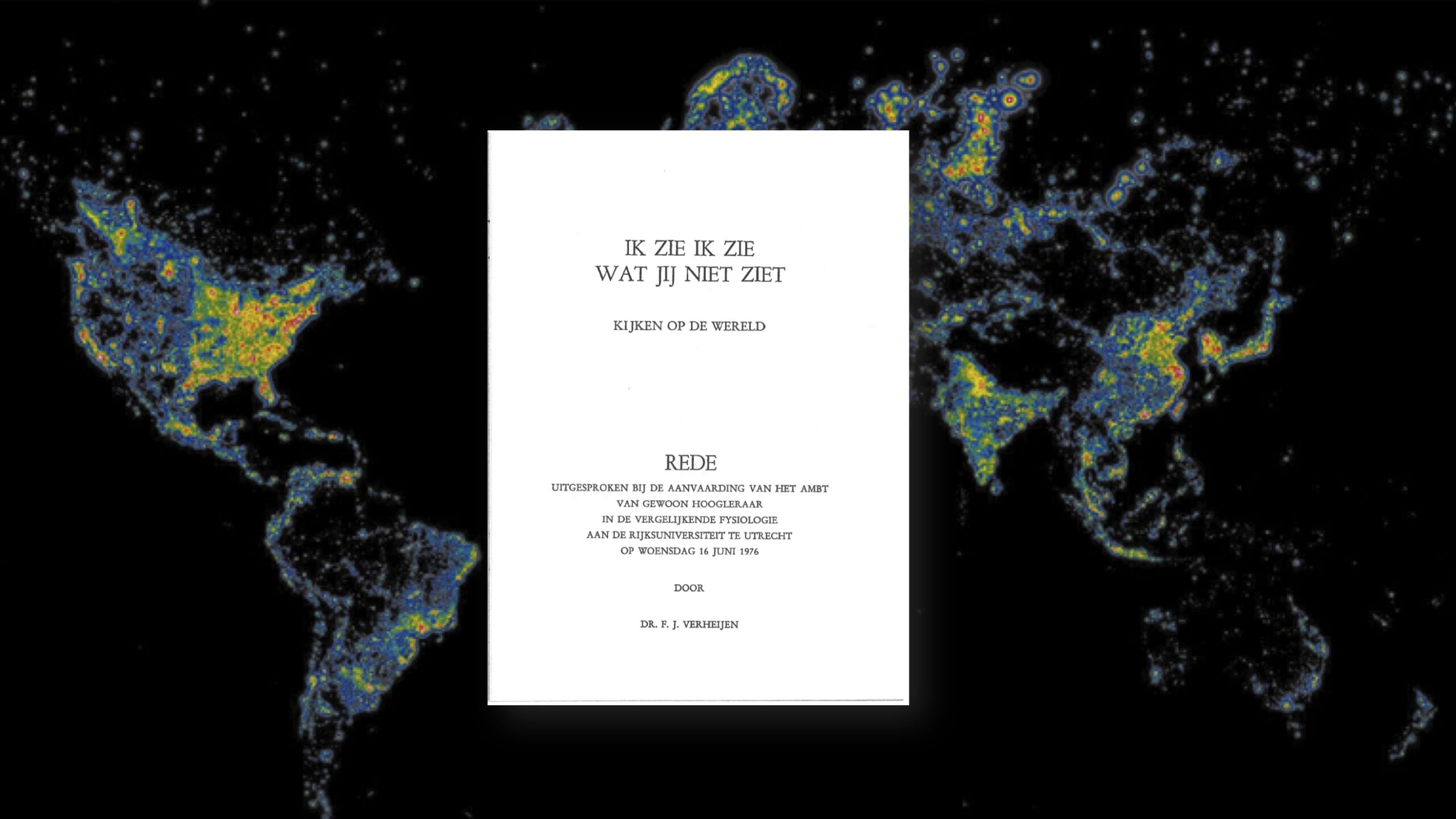
“I See That I See What You Don’t See” is a project presented by the Dutch pavilion, curated by Angela Rui, Marina Otero Verzier, and Francien van Westrenen, in the context of the XXII Triennale di Milano,(March 1 – September 1, 2019). “I See That I See What You Don’t See” questioned the overarching yet invisible presence of a hyperconnected and controlled environment where the borders between nature, ecology, technology, and culture increasingly fade, and speculated on design as both problem and solution, as a destructive as well as a restorative endeavor. Designers, artists, and researchers from the Netherlands and further afield presented a layered picture of the current multi-species relationship with Darkness, setting in motion imaginative critical responses to it, evidencing how current modes of understanding the environment are designed, and how they could, therefore, be redesigned.
Allowing the exhibition to serve as a reference point, for the notion of Presence of Absence, and the absence of physicality that the global community experienced during the COVID-19 pandemic, MDFF Greece invited Italian curator, design critic, and researcher, Angela Rui, to share her thoughts, and observations concerning emerging parallelisms, new ways of designing and redesigning our perspectives, as well as new forms of cultural production. In this visual essay, Angela Rui presents 10 different viewpoints – A Design Parallax ( *Parallax: the effect whereby the position or direction of an object appears to differ when viewed from different positions, e.g., through the viewfinder and the lens of a camera), connected to the way we experience and inhabit the world as well as the complex systems that define our relationship with nature, with the planet, and other beings.
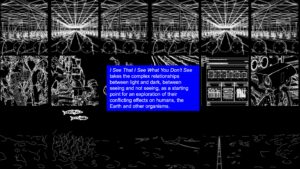
Animations by Rudy Guedj for the Dutch Pavilion, XXII Triennale of Milan, 2019
01
Ik Zie Ik Zie Wat Jij Niet Ziet (I See That I See What You don’t See)
Dr.F.J. Verheijen
2019
Finding a title for something that represents the consequences of missing darkness is not such an easy task. We borrowed it from a speech given by Dr. F.J. Verheijen in 1976 when he was awarded the chair in Comparative Physiology at the University of Utrecht.
His dissertation focused on the influence of artificial light on animal behaviour, calling for direct observation of nature, beyond the effects that it had on solely humans or from an only human vantage point. What we understood from his thesis is that, in a way, those animals became us: the more productive-oriented our environment becomes, the more we need to protect ourselves from it. What this pandemic has clarified is the fall of the old paradigm that positions humans outside of nature. Just reflect on the notion of self-isolation: on the one hand, it is the key to stopping contagion, but at the same time, the need for isolation is the recognition of our profound integration with the environment.
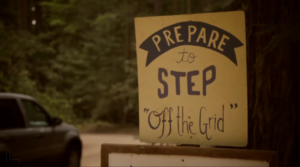
Still from Bregtje Van Der Haak, White Spots, 2019
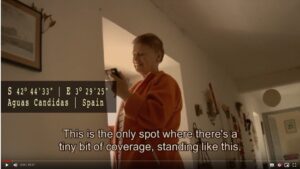
Still from Bregtje Van Der Haak, White Spots, 2019
02
White Spots
Bregtje Van Der Haag
White-spots.net
2019
“White Spots” is a collaborative multimedia project by Bregtje van der Haak, Jacqueline Hassink, and Richard Vijgen that explores the global divide between the connected and unconnected worlds. While sparsely populated areas experience low connectivity for obvious economic reasons, the work displays amazing stories of an often-deliberate lack of connectivity even within the world centres most firmly connected to the digital network. In the last few years, more and more people who live in developed countries suffer from allergies to electromagnetic fields and waves, to which we are all overexposed and which stem from the persistence of digital devices in our lives, both collective and individual. A large number of people abandoned their cities in order to find shelter in remote places lacking any connectivity. The documentary film by Bregtje Van Der Haag, which was presented at the Dutch pavilion of the XXII Milan Triennale, leads us beyond the networked world’s frontiers to explore landscapes, communities, and lifestyles off the grid. At the same time, it questions our constant need to be connected in one seamless planetary Techtopia.
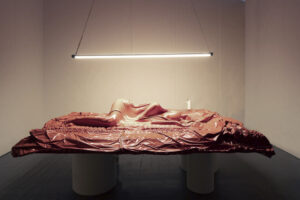
Lucy McRae, Compression Cradle, 2019, Photo Credit: Daria Scagliola
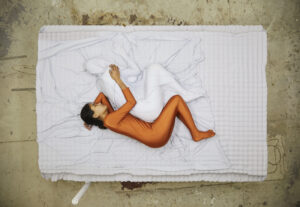
Lucy McRae, Compression Cradle, 2019, Photo Credit: Scottie Cameron
03
Compression Cradle
Lucy McRae
2019
Compression Cradle appears to be a remnant from a world we have not yet seen but might soon inhabit; one where the digital promise of a “perennial connectedness” has triggered a disconnection that isolates us from our own selves. Although from an unthinkable perspective, like the one given to us by Covid-19’s global diffusion, it seems that this time has come: we find ourselves living in a physical isolation deprived of social proximity, which has resulted in an excessive consumption of online communications on the countless platforms available. (That is if you have the privilege of a house and connection, anyway.)
In an attempt to cope with this future that assumes a lack of physical contact, the machine designed by Lucy McRae embraces the body, which is tightly squeezed by a membrane that withdraws as a result of a vacuum sealing effect. This mechanism stimulates the release of oxytocin – the hormone responsible for building trust and bonding between couples. Several people have written to us during the lockdown, remembering the Compression Cradle experience and dreaming of having one available to be able to “cure” their need for physical contact with other bodies.
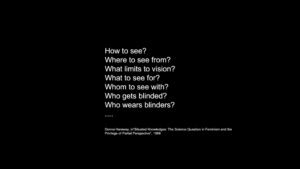
From Donna Haraway, “Situated Knowledge. The Science Question in Science, and the Privilege of Partial Perspective”, in Feminist Studies, Vol.14, n.3, 1988

From the article published by The Guardian on May 1st, 2020, “Japanese Aquarium Urges Public to Video-chat Eels who are Forgetting Humans Exist.” Auth: Justin McCurry
04
Out of God Trick
It has often been said during the lockdown period that the climate crisis would need the Covid-19 press office. Protecting our own species is certainly fundamental, but it is equally necessary to implement global policies to redesign our relationship with nature, with the planet, with other beings, leaving behind a colonial and extractive logic. However, the implementation of all this requires a change of perspective, a priori, in which the culture of design arises as a critical practice that calls in question the conventional ways of inhabiting and experiencing the world, on the basis of human control and the exploitation of other beings. It is necessary to understand where this is coming from, what attitudes and viewpoints are adopted in order not to resort to what Donna Haraway provocatively defines as the “God-Trick”: a trick based on the illusion of eliminating the “body” of knowledge. Ecological thinking today – in view of environmental emergencies, the extinction of species, and climate change – could be another way of applying situated knowledge and connecting this concept with the notion of post-human, potentially creating new forms of solidarity with other beings. This tendency invites us to consider an interconnected thinking, generated by a collective of knowledge producers, which yet loses its boundaries and complicates its own form.

Image of an aquarium’s section published in “La Nature,” n.1415, p.293, 1900
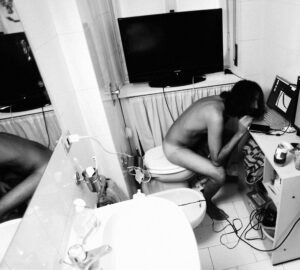
Hikikomori connected from his bathroom. Photo Credit: Alex Panichi
05
Living Within an Aquarium
Aquariums (like zoos) are complicated infrastructures which translate marine nature inτο culture, through sophisticated management and complete control of the climatic environment – an expression of the most advanced technology. Therefore, they are devices that organize environments and species in closed-loop worlds, whose policy, linked to our relationship with the environment, to building knowledge about the sea, and to the social role of entertainment, is an expression of the very notion of modernity.
Working on this subject in preparation for the Aquaria exhibition, opening in Lisbon’s MAAT in February 2021, the last weeks of the lockdown were in this sense revelatory for understanding the opportunities and loopholes created by technology. We continued to operate from our “techno-tanks,” which became comfort zones and at the same time prisons, where the mediation of the screen seemed to be the only form of contact with an exterior, which in reality was nothing more than another water tank. The domestic vulnerability was disguised by digital backgrounds within a system of suspended communicating vessels, closed ecosystems, in order to regain an ideal image of a unique nature.
The house, or any specific room of the house, becomes a communication device, the control panel of our own existence. This condition recalls that of Hikikomori, a term attributed to people who withdraw from real social interaction, living for long periods in a room of their house (often the bathroom), and whose only contact with the external world is established through the internet.
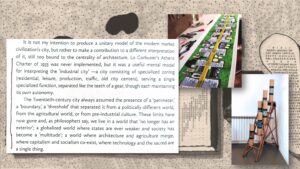
Mixed materials from “10 Modesti Consigli per una Nuova Carta di Atene”, by Andrea Branzi e Angela Rui, 2013
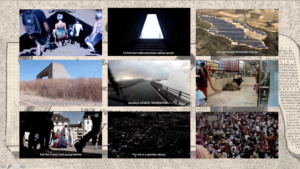
Still from “Sette Miliardi”, a film directed by Max Rommel, written by Angela Rui, 2014
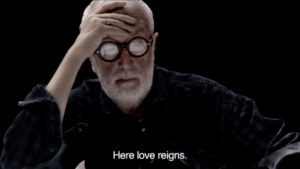
Still from “Sette Miliardi”, a film directed by Max Rommel, written by Angela Rui, 2014
“Seven billion stories, seven billion faces, seven billion exceptions, seven billion ambitions…”
“Sette Miliardi” (Seven Billion) is a short movie directed by Max Rommel and written by Angela Rui, which was presented at the 2014 edition of the Milano Design Film Festival, and is part of the 1st edition of MDFF Greece—Athens program. “Sette Miliardi” aims to present the imagery of the worldwide known design theoretician and designer, Andrea Branzi. The movie’s subject is Andrea Branzi and the thoughts he developed after working for four years on Dieci Modesti Consigli per una Nuova Carta d’Atene (Edizioni Lithos Como, 2014), a manifesto of ten principles that help the reader interpret the new condition of post-modern cities.
06
Sette Miliardi (Seven Billion)
2014
“Sette Miliardi” was born as a tribute to the ideas of Andrea Branzi, a design theoretician, and my mentor, whom I had interacted with for a long time during my doctoral studies. We worked for almost two years, every weekend, on “Dieci Modesti Consigli per una Nuova Carta d’Atene” (10 Modest Recommendations for a New Athenian Manifesto). I always thought of that time as a gift; it was only later that I understood what we were doing. In any case, the first challenge was to succeed in writing a four-handed braided text, in the form of a tartan. The “recommendations” appeared at the center of the text columns, intertwined by the horizontal text. The work became a scroll, of which only six copies exist, 7 meters long and entirely hand-drawn. We had in mind the manuscript of “On the Road”. It was a theoretical but also a conceptual project, in search of a format operating as the ideal mean. Out of the various recommendations, I like to mention the third and the fourth because, at this exact moment, several years later, they seem to me like teachings to revisit.
Third Recommendation
Consider the city as a place of “cosmic hospitality”: encourage planetary coexistence between man and animals, technology and divinities, living and dead, as in the Indian metropolis; cities that are less anthropocentric and more open to biodiversity, to the sacred, and human beauty.
Fourth Recommendation
Consider new models of weak urbanization; imagine permeable districts between city and country, hybrid semi-urban and semi-agricultural places; and productive and hospitable areas that follow the changing of the seasons and climate, creating widespread and reversible conditions of livability. What kind of images can this permeability of spaces, times, cultures, and activities create? The film’s format was the result of experimentation as if it were a collage or post-production at all levels, starting from the writing to the moving images. The idea was to bring Andrea’s thought out of the disciplinary field, liberating it for wider use. The film ends with a portrait of Andrea, who is dimly lit, seated alone at his table, as if in a dream locked inside his mind – reciting “Here Love reigns,” a passage by Petrarch in “Clear, fresh and sweet waters”. A space-time dimension of ecstasy between past and future, in which the present remains suspended.
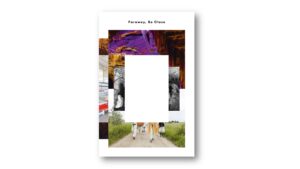
Cover of “Faraway, So Close”, the accompanying book of the 25th Biennial of Design of Ljubljana, curated by Angela Rui and Maja Vardjan, 2017
In 2017 Angela Rui co-curated with Maja Vardjan, the 25th Biennial of Design in Ljubljana, “Faraway, So Close” organized by the Museum of Architecture and Design.
“Faraway, So Close”— responds to the observation that although the city remains the model within which the evolution of contemporary society is discussed and interpreted, we are now witnessing a growing percentage of people that leave the city for other contexts and environments. The cause of this trend varies — from the post-2008 economic crisis, when cities began to become unsustainable, especially for the new generations, to the fact that several countries have activated concession programs for abandoned land, buildings and villages, granted free of charge under the presentation of conversion and new use projects. The Biennial develops from the physical exploration of seven conditions all over Slovenia on which designers were invited to reflect. This is a contemporary phenomenon characteristic of our era: young, informed and emancipated people who have grown up within urban models bring their values into non-urban spaces.”
The framework of “Faraway, So Close” is an experiment in formats: the designers have been asked to think of a potentially novel interpretation of Slovenian local dimension in order to generate new questions that are relevant also in a broader context. The structure of the biennial, as well as its dislocation, is pushing designers, disciplines and institutions outside their comfort zones.”
International creative figures, called Translators, have been chosen for their ability to use design and architecture as tools to inquire into contemporary issues. Alongside them, selected Slovenian individuals from various fields, called Profiles, have offered their knowledge and experience as initial inspiration to start a discourse around design research efforts developed within BIO 25. Divided into seven episodes, participants develop possible scenarios as forms of speculation that respond to the question of inventing a common world, of realizing a global space for exchange.
07
Faraway, So Close
2017
Faraway, So Close” is a loose title suggesting a state of thought. It has been an occasion to test that holistic understanding of the surroundings, opening up the possibility of deejaying with the notion of time, space, and myriads of interrelations.
In the formulation of the proposal, at one point, data from the research indicated a shift, a weak change on which we decided to focus on: more and more people in Europe were leaving the cities and settling in rural and other non-urban settings. There were many factors behind this relocation. Most of them related to economic accessibility, together with the fear effect that is the result of recent and unexpected assaults on our notion of stability.
Slovenia, with its specific geographical, political, and economic features marked as predominantly rural, seemed to be the ideal territory to discuss the impact of this global shift towards the non-urban contexts. BIO 25 worked to intensify local-global interactions. Each location became a discursive place for design-related speculation, activating collective discussion on the failure of the utopian ideas of progress, looking especially at the 20th century’s critical impulses – industrialization, modernization, ideas of socialism and their failure.
During the time of Covid-19 we witnessed a reinforcement of the critique towards paradigms around globalization within the narrative of an interconnected ecology, where the human health is directly linked to the health of the planet.
Therefore, the notion of circularity should become a methodology to apply not only to the economy but also to other kinds of values, such as health. Circular health refers to the right of health for minorities, other beings – like animals and plants – and terrestrial agents, including our health. It’s a really basic concept.
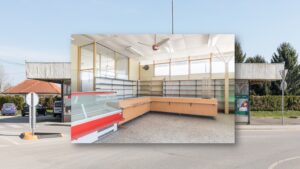
A closed supermarket in Lendava, in the Slovenian countryside, was elected by Mischer’Traxler as one of the locations where the episode “Countryside Reloaded” was set. “Faraway, So Close,” 25th Biennial of Design, Ljubljana, 2017
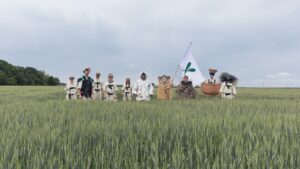
Mischer’Traxler, “The Dandelion Parade,” project developed in the occasion of “Faraway, So Close”, 25th Biennial of Design, Ljubljana, 2017
08
Which Countryside?
Among the seven episodes of “Faraway, So Close,” the design duo Mischer’ Traxler worked in the region of Lendava, close to the border with Hungary. There the countryside has been temporarily transformed into a land of knowledge where food production, consumption, and information are experienced along a 4-km-tour that offers not only walking but also foraging and eating. The empty supermarket has been chosen as the starting and ending point of the food tours. It has been transformed into a fleeting place for social exchange conveyed from the experience of food, that is still active as a community centre.
The designers’ team performed as a collective (known as the Dandelion parade), wearing clothes designed by them, among the workers’ overalls (symbolically referring to labour and industry). The local hand-made props indicated the reawakening of ritualisms that once happened in those fields, during a time when the countryside was defined by a highly ritualized localism and farming arising from a personal relationship with the land, nature, and animals. In the fields, a series of installations of autonomous agricultural machines ideally suggested to take on human labour, giving back the possibility of a re-appropriation of the land that excludes human labour.
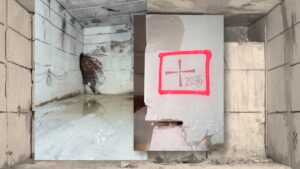
A cave and a quarry sets for “Underground Release,” the episode led by Formafantasma. “Faraway, So Close,” 25th Biennial of Design, Ljubljana, 2017
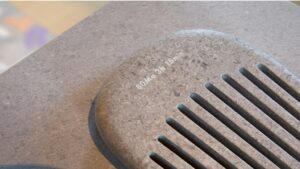
Formafantasma, comb from the collection “Underground Release”, developed in the occasion of “Faraway, So Close”, 25th Biennial of Design, Ljubljana, 2017
09
What Time?
The closest episode to Ljubljana was the Županova Jama, a great cave approximately half an hour driving from the capital. Formafantasma, the Amsterdam based design duo leading the project, approached the theme replying to the question: “What would happen if we extend our definition of the time of production by including the time needed for raw materials to form?”
They focus on the appropriation moment by the extraction of the material (the quarry), the instant where a natural material becomes valued, utilized, transformed, or mythologized by humans. Even when we understand that these two worlds are part of the same natural domain: extraction ends because a cave starts. Furthermore, time is embedded in the material itself and within the projection of availability of that material in that specific site. So in this case design speculates on its own role, and the comb(part of the collections designed by Formafantasma), actually produced by the owner of the quarry, brings the notion of time as the perfect paradigm that permits to connect with the complexity of production, and with the complicated issue of mining. The message is unambiguous: geological time of matter production that counts 80 million years remains embedded in the time of the industrial output that counts 3h 15min.
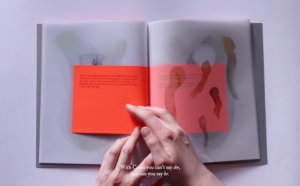
Benedetta Pompili and Eleonora Toniolo, “Ciona are Doing Well”, children’s book, 2020
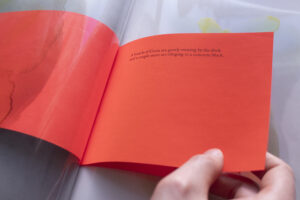
Benedetta Pompili and Eleonora Toniolo, “Ciona are Doing Well”, children’s book, 2020
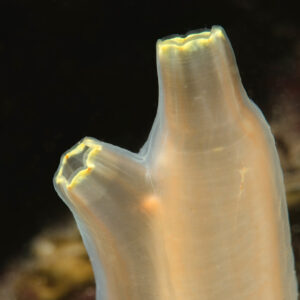
Ciona Intestinalis, a sea squirt that lives despite pollution and spreads through anthropogenic means. A symbol of resistance to human exploitation of the sea
10
What Future?
Pedagogies of the Sea
Video: https://vimeo.com/401956970
The pandemic of SARS-CoV-2 is an ongoing global tragedy. It is also an opportunity to think, in general terms, of the currents in which we swim. The philosopher Emanuele Coccia claims that we inhabit not the Earth but the atmosphere, which he describes as a sea of life; as swimmers in this sea, we cannot be biologically isolated. Neither can our ecological practices. In this sense, creators – whether they are thinkers, artists, or designers – and institutions could intervene in fields that need their ability to translate, identify challenges and inequalities, common goods not yet valued, and open up spaces of transgression.
As a mentor at the Design Academy of Eindhoven, I teach with Anastasia Kubrak, a design research course entitled “Pedagogies of the Sea” in order to learn from an almost unknown agent the Ocean, of which only 5% is known. At the same time, we are interested in experimenting with pedagogical forms, training new generations in shaping critical practices that will reformulate how we coexist with other beings on this planet.
One of the works produced this year is the result of a cognitive survey on a species, Ciona Intestinalis, completely unknown outside the scientific sphere. An “alien” and complex life form spelled through a children’s book publication.
In the words of the creators, Benedetta Pompili and Eleonora Toniolo: “The galloping defaunation of the oceans, the continuous attempts of humankind to exploit its resources, the rampant increase of carbon dioxide in the atmosphere, all induce for the future itself to be questioned. But whose future? For Ciona, there surely is one; and they might even outlive humankind. Ciona intestinalis, a sea squirt that lives despite pollution and spreads through anthropogenic means, is a symbol of resistance to human exploitation of the sea. Due to their peculiar development history, they teach us about the non-linearity of evolution, and they force us to question anthropocentrism. The book focuses on this little-known organism, unconsidered and unrepresented in culture. It tells the life of Ciona while showing the resilient features that makes them such a special animal. Through a down to earth playful tone, it aims to familiarize the readers with this alien-looking being, that is genetically closer to humans than expected.”
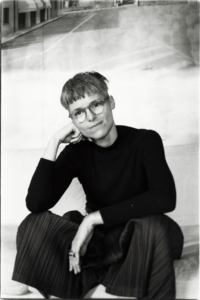
Angela Rui, Photo Credit: Francesco Barion
About Angela Rui
Angela Rui is an Italian curator and researcher based in Milan, working in design theory and criticism. She got her PhD in Exhibition Design at the Politecnico of Milan, Faculty of Architecture (2011). She recently collaborated as researcher with the Het Nieuwe Instituut (Rotterdam) for the Neuhaus project – the temporary transdisciplinary academy for more-than-human knowledge; among other projects, she co-curated I See That I See What You don’t See, the Dutch Pavilion for Broken Nature – the XXII Triennale di Milano (2019), the 25th Design Biennial of Ljubljana (2017) and the accompanying book, both titled Faraway, So Close, and the 2015 edition of Operae, the independent design festival based in Turin. She has been design editor for Abitare magazine (2011-2013), and curated the editorial project of Icon Design magazine (Mondadori, 2015-2017). Until 2016 she taught at the School of Design (Politecnico di Milano) and at the Master of Interior Design program at NABA (Nuova Accademia di Belle Arti in Milan). She currently teaches at the Design Academy Eindhoven, Geo Design Master, where she run a research class titled Pedagogies of the Sea.
Content Curation by Annie Markitanis, Director of Milano Design Film Festival Greece & Cyprus, Partner of MDFF